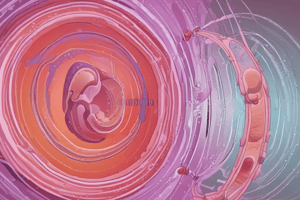Podcast
Questions and Answers
Which of the following is NOT a direct consequence of high inflation on an economy?
Which of the following is NOT a direct consequence of high inflation on an economy?
- Increased economic stability (correct)
- Weakening of currency
- Distorted resource allocation
- Reduced investment
Which type of inflation is characterized by a price increase of 10-100% per year?
Which type of inflation is characterized by a price increase of 10-100% per year?
- Hyperinflation
- Galloping inflation (correct)
- Creeping inflation
- Deflation
How can monetary policy be used to control inflation?
How can monetary policy be used to control inflation?
- Lowering taxes to increase disposable income
- Increasing government spending on infrastructure projects
- Increasing interest rates to curb spending (correct)
- Reducing interest rates to stimulate spending
Which of these policies is considered a supply-side strategy to control inflation?
Which of these policies is considered a supply-side strategy to control inflation?
What is the main disadvantage of using wage and price controls to combat inflation?
What is the main disadvantage of using wage and price controls to combat inflation?
Which of the following is NOT a cause of cost-push inflation?
Which of the following is NOT a cause of cost-push inflation?
What is the primary mechanism by which demand-pull inflation occurs?
What is the primary mechanism by which demand-pull inflation occurs?
What is the main consequence of imported inflation?
What is the main consequence of imported inflation?
Which of the following inflation measures tracks the average price changes for consumers in urban areas?
Which of the following inflation measures tracks the average price changes for consumers in urban areas?
How does inflation impact income inequality?
How does inflation impact income inequality?
What is the primary measure of inflation?
What is the primary measure of inflation?
Which type of inflation refers to a cycle of rising prices and wages driven by past inflation?
Which type of inflation refers to a cycle of rising prices and wages driven by past inflation?
Which of the following is NOT a negative effect of inflation?
Which of the following is NOT a negative effect of inflation?
Flashcards
Economic Instability
Economic Instability
High inflation destabilizes the economy, reducing investment and employment.
Reduced Investment
Reduced Investment
Uncertainty about money's future value discourages investment.
Monetary Policy
Monetary Policy
Central banks control inflation by adjusting interest rates.
Creeping Inflation
Creeping Inflation
Signup and view all the flashcards
Hyperinflation
Hyperinflation
Signup and view all the flashcards
Implasyon
Implasyon
Signup and view all the flashcards
Demand-pull inflation
Demand-pull inflation
Signup and view all the flashcards
Cost-push inflation
Cost-push inflation
Signup and view all the flashcards
Built-in inflation
Built-in inflation
Signup and view all the flashcards
Monetary inflation
Monetary inflation
Signup and view all the flashcards
Imported inflation
Imported inflation
Signup and view all the flashcards
Consumer Price Index (CPI)
Consumer Price Index (CPI)
Signup and view all the flashcards
Effects of inflation
Effects of inflation
Signup and view all the flashcards
Study Notes
Definition of Implasyon
- Implasyon is a sustained rise in the general price level of goods and services.
- This reduces the buying power of money.
- Inflation is measured by the rate at which the average price of a basket of goods and services increases.
Causes of Implasyon
- Demand-pull inflation: Occurs when demand for goods and services exceeds supply. This excess demand drives prices up. Government spending, consumer confidence, and expansionary monetary policy increase demand.
- Cost-push inflation: Higher production costs lead to higher prices. Rising wages, raw material costs, supply chain disruptions, and fluctuations in exchange rates are factors.
- Built-in inflation: Inflation expectations cause a cycle. Previous inflation shapes expectations and results in higher prices and wages in subsequent periods.
- Monetary inflation: Excessive money supply growth leads to inflation. If the government or central bank increases the money supply quicker than economic growth, the value of money falls.
- Imported inflation: Increased imported goods and services push up domestic prices. Exchange rate changes and global economic conditions contribute to this.
Measurement of Implasyon
- The Consumer Price Index (CPI) is a common inflation measurement.
- CPI tracks the average change in prices urban consumers pay for a set of consumer goods and services.
- Other measures include the Producer Price Index (PPI). PPI measures inflation at the wholesale level.
- The GDP deflator measures price changes of all goods and services in the gross domestic product (GDP).
Effects of Implasyon
- Reduced purchasing power: Increased prices mean less can be bought with the same amount of money.
- Income inequality: Inflation disproportionately harms lower-income households with fixed incomes.
- Economic uncertainty: High and unpredictable inflation makes planning and investing difficult for businesses.
- Economic instability: High inflation destabilizes the economy leading to decreased investment, production, and employment.
- Reduced investment: Investor confidence declines due to uncertainty about the future value of money.
- Distorted resource allocation: Inflation leads to misallocation of resources when some industries are more affected than others.
- Weakening currency: High inflation decreases the domestic currency's value against other currencies.
Strategies to Control Implasyon
- Monetary policy: Central banks can control inflation with interest rate adjustments. Increased interest rates reduce spending, slowing demand and inflation.
- Fiscal policy: Government spending and taxation can affect inflation. Higher taxes decrease disposable income, reducing demand.
- Supply-side policies: Policies that improve productive capacity ease supply constraints, controlling inflation.
- Wage and price controls: Attempts to limit price increases, often ineffective and creating shortages.
- Exchange rate management: A flexible exchange rate helps absorb inflationary pressures from imported goods.
Types of Implasyon
- Creeping inflation: Slow and steady increase (e.g., 2-3% annually).
- Galloping inflation: Faster price increases (e.g., 10-100% annually).
- Hyperinflation: Rapid and extreme price increases (hundreds or thousands of percent annually). This is a serious economic crisis.
Studying That Suits You
Use AI to generate personalized quizzes and flashcards to suit your learning preferences.




